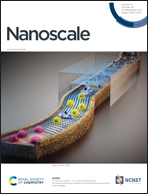Bioinspired Camellia japonica carbon dots with high near-infrared absorbance for efficient photothermal cancer therapy†
Abstract
Since carbon dots (CDs) exhibit excellent biocompatibility, low cytotoxicity, near-infrared (NIR) absorbance, and superior photostability, many types of CDs are considered as powerful candidates for photothermal therapy (PTT) applications. However, the development of a desirable CD is still difficult due to insufficient photothermal conversion, thus resulting in the use of high laser power densities at a high dose of CDs for the PTT effect. Herein, bioinspired sulfur-doped CDs (S-CDs) with strong NIR absorbance were prepared from Camellia japonica flowers via a facile hydrothermal method for enhancing the photothermal conversion efficiency. The as-prepared S-CDs exhibited various advantages including cost-effective preparation, good water-solubility, high biocompatibility, intense NIR absorption, and excellent photothermal effect with robust photostability. Most importantly, the optimal low dose of S-CDs (45 μg mL−1) successfully led to efficient PTT performance with a high photothermal conversion efficiency (55.4%) under moderate laser power (808 nm, 1.1 W cm−2) for safe and effective cancer therapy.



 Please wait while we load your content...
Please wait while we load your content...